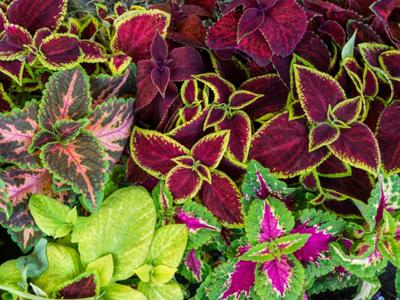For many of us, a passion for flowers drew us into gardening in the first place. But in time, even the most ardent lover of all things petaled has to admit that a garden based only on blooms is missing something. That’s when we look to the leaf, and suddenly it’s all about foliage.
Artfully paired with other plants in a container or out in the garden, fine foliage gives textural interest and a long season of ravishing color that’s not possible with flowers or grasses alone. Enduring ebbs and flows in popularity over the past two centuries, coleus has perhaps the longest history of use as a foliage plant than any other plant.
The Victorians loved coleus (a native of Southeast Asia) and used it as a key element in their elaborate “carpet gardens,” igniting nothing less than “coleus fever” back in the day. But like so many fads, interest in coleus faded until the mid-20th century when uniform, seed-grown varieties made it popular again. As a college student in the 1970s with no outdoor growing spaces of my own, I grew coleus as a houseplant in beaded macramé hangers. And a few years later, I dated a guy who grew coleus as a colorful summer annual right in the soil along his shaded fence in Buffalo, N.Y. I thought it was absolutely brilliant, and I eventually married him.
As interest in coleus increased, breeders got busy. Today, over 600 varieties, with some of the most creative names in horticulture, are available. Just try to top “Religious Radish,” “Duke of Swirl,” “Fishnet Stockings” and “Bipolar by Golly.” And if their names don’t spark your interest, their amazing color palette will. You’ll find all shades of green, pink, yellow, orange, red, burgundy, nearly black, bronze, cream and white. Sometimes leaves are a single sensational color, but most likely you’ll see a rainbow of splashes, splotches, streaks, dots, borders and veins. And if that’s not enough, the underside of the leaf sometimes features a contrasting color that only adds to the impact.
Along with color, leaf texture varies dramatically. Leaves can be enormous (look for the Kong series, as in “King Kong”), or delicate and tiny. They can be twisted, crinkled, ruffled, elongated, scalloped, lobed, fingerlike or webbed like a duck’s foot. Plants can be low-growers from 12 to 18 inches tall and are often trailing types; bushy and mid-sized at 18 to 25 inches tall; or tall and upright at over 25 inches.
Coleus has long been considered a shade plant, and many varieties continue to thrive in dappled, but never deep, shade. However, breeders have brought coleus into full sun, with loads of cultivars that thrive in Yakima’s blazing summers. Make sure you check the tag if you’re looking for a plant with sun-loving characteristics. Varieties with dark leaves can handle more sun, while the pastels may need more shade to avoid leaf scorch. Too little light will encourage a floppy, less vigorous plant without the best color.
A member of the square-stemmed mint family, coleus has always been easy to grow. They don’t tolerate wet feet, so give them well-drained soil in the garden or your favorite potting mix in containers with good drainage. Maintain moderate soil moisture and never allow the plants to wilt. For bushier plants, pinch back the growing tips to encourage branching, especially early in the season. If your potting mix doesn’t already contain a slow-release fertilizer, add some at planting time or apply a dilute soluble fertilizer monthly. If flower spikes appear, pinch them out. However, some of the new varieties yield a bushy plant without pinching, and there’s no need to remove flower spikes, making coleus even easier to grow.
Since they won’t survive freezing temperatures, coleuses are grown as annuals in our climate, but that’s no reason to surrender your plants to frost. Keep your favorites from year to year by taking cuttings in October, just before frost. It’s easy to root them in water, and then transplant them into 3 1/2-inch pots. Grow them in a sunny window or under plant lights through the winter. After the last frost date, move them back outside. Or grow some of the older varieties from seed sown indoors 8 to 10 weeks before our last frost date.
The ideal way to choose the perfect plant is to see it in person at your local nursery. If you haven’t looked at coleus lately, prepare to be bowled over.
I’ll bet you can’t choose just one.





(0) comments
Comments are now closed on this article.
Comments can only be made on article within the first 3 days of publication.